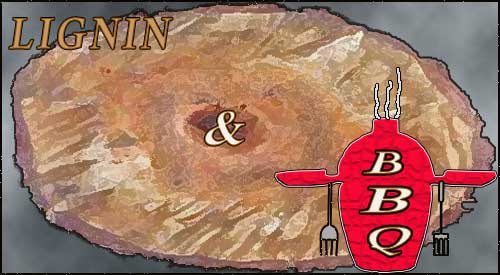
Wood Lignin is what produces the great flavor in Barbecue
Choosing wood species for their lignin can help your BBQ! Share on X
Let me start this article by first reminding you that wood contains hundreds of compounds that honestly, we don’t know everything about. For this reason, I am only speaking today regarding those known compounds and what they contribute to foods cooked by wood fire. Specifically, I’ll be looking at lignin which is the only large-scale biomass source that has aromatic functionality. In English, this is what gives wood-fired foods the distinct flavor and aroma.
Often, you read about specific flavors and aromas as they apply to meats but today, I want to delve into the compounds that are most prevalent by wood species and what they offer to food.
Lignin- A Refresher
Lignin is one of the primary compounds responsible for cell construction in a tree and makes up 15-30% of wood cells. It has a primary role in conducting water to feed the tree’s cells and when burned, yields a tremendous amount of energy. Plus, lignin produces rigidity in cell walls which prevents rot.
As a polymer or large molecule composed of many repeated subunits that bond together, it is the only one that is not composed of carbohydrate (sugar) monomers. Because lignin is a polymer, there are many possible bonding patterns between the individual units, thus, we don’t have full knowledge of all the possibilities.
What we do know is lignin contains phenols or hydroxyl groups which are alcohols. As these compounds work together, they produce a preservative action on the food which is antibacterial in nature. The surface of the smoked food is modified with resulting flavors and aromas which are associated with barbecued foods. Let’s take a closer look at these smoke vapor flavors.
Profiles of Smoke Compounds Share on X
If you recall our publication on wood-tar creosote we tapped into the science of wood-tar creosote and its purpose as a preservative as well as producer of flavor, color, and aroma to barbecued foods. In that article, we just barely mentioned the compounds responsible for the flavors. Let’s provide you with the main compound list and what the odor and flavor descriptors are.
Phenol: this compound provides the sharp, robust aromas and the astringent, sharp aftertaste to wood fired foods.
Dimethylphenol: another compound that has a sharp, robust odor that also has a sweet aromatic undertone. Flavors are sweet, charred, and astringent.
Isoeugenol: this is the compound associated with vanilla aromatics in addition to sweet and fruity. Flavor descriptors include sweet, smoked-ham notes, hydrolyzed vegetable protein-like, with clove-like undertones.
4-Methylguaiacol: another compound that includes vanilla-like, fruity, cinnamon-ish, and smoky odors, with flavors of caramel, vanilla, sweet, and pleasant notes.
o-Cresol: odors are smoked sausage like with robust, sharp undertones. This one on its own can produce more unpleasant smoky flavors.
Guaiacol: Smoky, sharp, aromatic aromas with flavors that are spicy, sharp, sweet and dry. This is the yellowish aromatic oil that forms from creosote.
Syringol: Sausage-like aromatic that is sharp and sweet, with a spicy note. These flavors include whiskey notes with smoky-char taste.
Lignin Levels in North American Hardwoods
I’m going to report the lignin levels of common North American hardwoods derived from the Klason lignin method, which values the residue remaining after solubilizing the carbohydrate with strong mineral acid. What follows are percentages of oven-dried woods with temperatures ranging from 68°F/20°C to 248°F/120°C.
Acer saccharum Marsh./Sugar Maple = 22%
Alnus rubra Bong./Red Alder = 24%
Betula alleghanienstis Britton/Yellow Birch = 21%
Carya glaubra (Mill.)/Sweet Pignut Hickory = 24%
Carya ovata (Mill.) K. Koch/Shagbark Hickory = 21%
Fagus grandifolia Ehrh./American Beech = 22%
Fraxinus Americana L./White Ash = 26%
Populus tremoides Michx./ Quaking Aspen = 19%
Prunus serotine Ehrh./Black Cherry = 21%
Quercus alba L./White Oak = 27%
Quercus prinus L./Chestnut Oak = 24%
Quercus rubra L./Northern Red Oak = 24%
Quercus stellate Wangenh./ Post Oak = 24%
What do all these percentages mean when it comes to your barbecue? You can assume that the higher numbers mean there are larger numbers of compounds at work to flavor your foods. It’s obvious that woods like hickory and oak have great percentages of phenol, guaiacol, and dimethylphenol, since these woods tend to produce the boldest flavors. Those hardwoods like cherry, alder, and maple have the compounds of methylguaiacol and isoeugenol coming forward in the flavors which results in sweeter and more toned coloring to meats. Another factor that must be kept in mind when examining lignin is the heat level the wood is exposed to. Cook at a higher temperature and these compounds can become muddier as combustion occurs more rapidly producing ash accumulation that can change flavors and aromas quickly. All factor in to the resulting flavor, color and aroma of barbecued foods, whether animal protein, vegetable, fruit, or other. This just further supports that wood-fired cooking is an art that requires a balanced hand that understands the importance of controlling as many factors as possible, primary of which is cooking temperature and airflow to bring out the highest percentage of beneficial compounds the wood can offer.
What is your favorite hardwood or mixture of hardwoods to cook with? Leave us a comment to share your views. Bringing you informative recipes, techniques, and the science beyond the fire, smoke, and flavor. That’s SmokinLicious®!
SmokinLicious® products:
Wood Chunks- Double & Single Filet
Wood Chips- Grande Sapore®, Minuto® & Piccolo®
More information on the composition of wood:
-6 REASONS WHY CEDAR WOOD SHOULD NOT BE YOUR TOP CHOICE FOR COOKING
-TO BARK OR NOT
-Lab Report on Moisture and storage of wood
-10 THINGS TO CONSIDER BEFORE PURCHASING WOOD FOR COOKING, GRILLING & SMOKING
